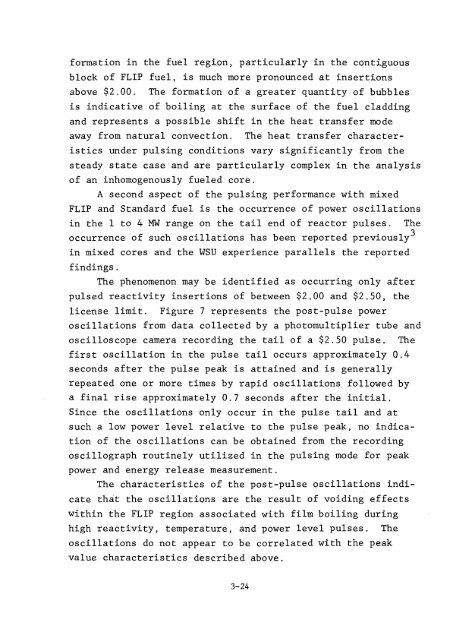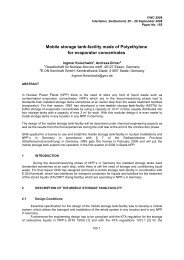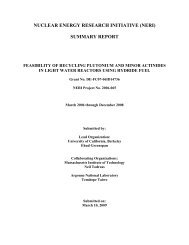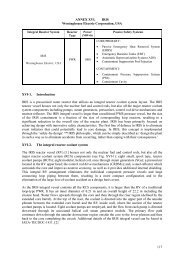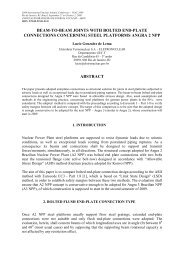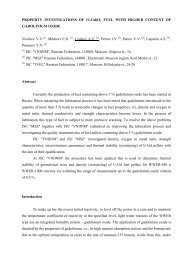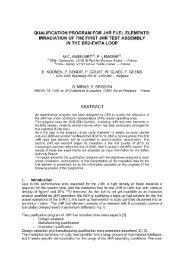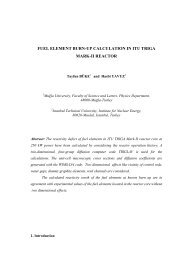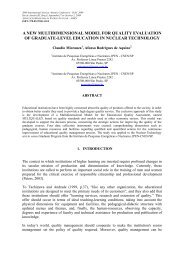Conversion of the WSU reactor to a mixed core of TRIGA- FLIP and ...
Conversion of the WSU reactor to a mixed core of TRIGA- FLIP and ...
Conversion of the WSU reactor to a mixed core of TRIGA- FLIP and ...
You also want an ePaper? Increase the reach of your titles
YUMPU automatically turns print PDFs into web optimized ePapers that Google loves.
formation in <strong>the</strong> fuel region, particularly in <strong>the</strong> contiguousblock <strong>of</strong> <strong>FLIP</strong> fuel, is much more pronounced at insertionsabove $2.00. The formation <strong>of</strong> a greater quantity <strong>of</strong> bubblesis indicative <strong>of</strong> boiling at <strong>the</strong> surface <strong>of</strong> <strong>the</strong> fuel cladding<strong>and</strong> represents a possible shift in <strong>the</strong> heat transfer modeaway from natural convection. The heat transfer characteristicsunder pulsing conditions vary significantly from <strong>the</strong>steady state case <strong>and</strong> are particularly complex in <strong>the</strong> analysis<strong>of</strong> an inhomogenously fueled <strong>core</strong>.A second aspect <strong>of</strong> <strong>the</strong> pulsing performance with <strong>mixed</strong><strong>FLIP</strong> <strong>and</strong> St<strong>and</strong>ard fuel is <strong>the</strong> occurrence <strong>of</strong> power oscillationsin <strong>the</strong> 1 <strong>to</strong> 4 MW range on <strong>the</strong> tail end <strong>of</strong> <strong>reac<strong>to</strong>r</strong> pulses. The3occurrence <strong>of</strong> such oscillations has been reported previouslyin <strong>mixed</strong> <strong>core</strong>s <strong>and</strong> <strong>the</strong> <strong>WSU</strong> experience parallels <strong>the</strong> reportedfindings.The phenomenon may be identified as occurring only afterpulsed reactivity insertions <strong>of</strong> between $2,00 <strong>and</strong> $2.50, <strong>the</strong>license limit. Figure 7 represents <strong>the</strong> post-pulse poweroscillations from data collected by a pho<strong>to</strong>multiplier tube <strong>and</strong>oscilloscope camera recording <strong>the</strong> tail <strong>of</strong> a $2.50 pulse. Thefirst oscillation in <strong>the</strong> pulse tail occurs approximately 0,4seconds after <strong>the</strong> pulse peak is attained <strong>and</strong> is generallyrepeated one or more times by rapid oscillations followed bya final rise approximately 0.7 seconds after <strong>the</strong> initial.Since <strong>the</strong> oscillations only occur in <strong>the</strong> pulse tail <strong>and</strong> atsuch a low power level relative <strong>to</strong> <strong>the</strong> pulse peak, no indication<strong>of</strong> <strong>the</strong> oscillations can be obtained from <strong>the</strong> recordingoscillograph routinely utilized in <strong>the</strong> pulsing mode for peakpower <strong>and</strong> energy release measurement.The characteristics <strong>of</strong> <strong>the</strong> post-pulse oscillations indicatethat <strong>the</strong> oscillations are <strong>the</strong> result <strong>of</strong> voiding effectswithin <strong>the</strong> <strong>FLIP</strong> region associated with film boiling duringhigh reactivity, temperature, <strong>and</strong> power level pulses. Theoscillations do not appear <strong>to</strong> be correlated with <strong>the</strong> peakvalue characteristics described above.3-24


